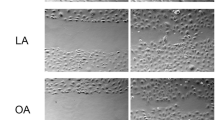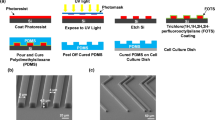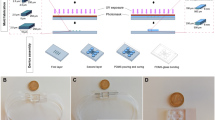Abstract
Olfactory ensheathing cells (OECs) are a unique type of glial cells that have axonal growth-promoting properties. OEC transplantation has emerged as a promising experimental therapy of axonal injuries and demyelinating diseases. However, some fundamental cellular properties of OECs remain unclear. In this study, we found that the distinct OEC subpopulations exhibited different migratory properties based on time-lapse imaging of single isolated cells, possibly due to their different cytoskeletal organizations. Moreover, OEC subpopulations displayed different attractive migratory responses to a gradient of lysophosphatidic acid (LPA) in single-cell migration assays. Finally, we found that OEC subpopulations transformed into each other spontaneously. Together, these results demonstrate, for the first time to our knowledge, that distinct OEC subpopulations display different migratory properties in vitro and provide new evidence to support the notion of OECs as a single cell type with malleable functional phenotypes.
Similar content being viewed by others
Log in or create a free account to read this content
Gain free access to this article, as well as selected content from this journal and more on nature.com
or
References
Graziadei PP, Graziadei GA . Neurogenesis and neuron regeneration in the olfactory system of mammals. I. Morphological aspects of differentiation and structural organization of the olfactory sensory neurons. J Neurocytol 1979; 8:1–18.
Doucette R . PNS-CNS transitional zone of the first cranial nerve. J Comp Neurol 1991; 312:451–466.
Ramon-Cueto A, Valverde F . Olfactory bulb ensheathing glia: a unique cell type with axonal growth-promoting properties. Glia 1995; 14:163–173.
Vincent AJ, West AK, Chuah MI . Morphological and functional plasticity of olfactory ensheathing cells. J Neurocytol 2005; 34:65–80.
Raisman G, Li Y . Repair of neural pathways by olfactory ensheathing cells. Nat Rev Neurosci 2007; 8:312–319.
Ramon-Cueto A, Nieto-Sampedro M . Regeneration into the spinal cord of transected dorsal root axons is promoted by ensheathing glia transplants. Exp Neurol 1994; 127:232–244.
Smale KA, Doucette R, Kawaja MD . Implantation of olfactory ensheathing cells in the adult rat brain following fimbria-fornix transection. Exp Neurol 1996; 137:225–233.
Ramon-Cueto A, Plant GW, Avila J, Bunge MB . Long-distance axonal regeneration in the transected adult rat spinal cord is promoted by olfactory ensheathing glia transplants. J Neurosci 1998; 18:3803–3815.
Imaizumi T, Lankford KL, Waxman SG, Greer CA, Kocsis JD . Transplanted olfactory ensheathing cells remyelinate and enhance axonal conduction in the demyelinated dorsal columns of the rat spinal cord. J Neurosci 1998; 18:6176–6185.
Kato T, Honmou O, Uede T, Hashi K, Kocsis JD . Transplantation of human olfactory ensheathing cells elicits remyelination of demyelinated rat spinal cord. Glia 2000; 30:209–218.
Li Y, Field PM, Raisman G . Regeneration of adult rat corticospinal axons induced by transplanted olfactory ensheathing cells. J Neurosci 1998; 18:10514–10524.
Franklin RJ, Gilson JM, Franceschini IA, Barnett SC . Schwann cell-like myelination following transplantation of an olfactory bulb-ensheathing cell line into areas of demyelination in the adult CNS. Glia 1996; 17:217–224.
Lu J, Feron F, Mackay-Sim A, Waite PM . Olfactory ensheathing cells promote locomotor recovery after delayed transplantation into transected spinal cord. Brain 2002; 125:14–21.
Navarro X, Valero A, Gudino G, et al. Ensheathing glia transplants promote dorsal root regeneration and spinal reflex restitution after multiple lumbar rhizotomy. Ann Neurol 1999; 45:207–215.
Cao L, Liu L, Chen ZY, et al. Olfactory ensheathing cells genetically modified to secrete GDNF to promote spinal cord repair. Brain 2004; 127:535–549.
Feron F, Perry C, Cochrane J, et al. Autologous olfactory ensheathing cell transplantation in human spinal cord injury. Brain 2005; 128:2951–2960.
Valverde F, Santacana M, Heredia M . Formation of an olfactory glomerulus: morphological aspects of development and organization. Neuroscience 1992; 49:255–275.
Astic L, Pellier-Monnin V, Godinot F . Spatio-temporal patterns of ensheathing cell differentiation in the rat olfactory system during development. Neuroscience 1998; 84:295–307.
Chuah MI, West AK . Cellular and molecular biology of ensheathing cells. Microsc Res Tech 2002; 58:216–227.
Key B, St John J . Axon navigation in the mammalian primary olfactory pathway: where to next? Chem Senses 2002; 27:245–260.
Barnett SC, Chang L . Olfactory ensheathing cells and CNS repair: going solo or in need of a friend? Trends Neurosci 2004; 27:54–60.
Au E, Roskams AJ . Olfactory ensheathing cells of the lamina propria in vivo and in vitro. Glia 2003; 41:224–236.
Deng C, Gorrie C, Hayward I, et al. Survival and migration of human and rat olfactory ensheathing cells in intact and injured spinal cord. J Neurosci Res 2006; 83:1201–1212.
Pearse DD, Sanchez AR, Pereira FC, et al. Transplantation of Schwann cells and/or olfactory ensheathing glia into the contused spinal cord: survival, migration, axon association, and functional recovery. Glia 2007; 55:976–1000.
Pixley SK . The olfactory nerve contains two populations of glia, identified both in vivo and in vitro. Glia 1992; 5:269–284.
Franceschini IA, Barnett SC . Low-affinity NGF-receptor and E-N-CAM expression define two types of olfactory nerve ensheathing cells that share a common lineage. Dev Biol 1996; 173:327–343.
Alexander CL, Fitzgerald UF, Barnett SC . Identification of growth factors that promote long-term proliferation of olfactory ensheathing cells and modulate their antigenic phenotype. Glia 2002; 37:349–364.
Kumar R, Hayat S, Felts P, Bunting S, Wigley C . Functional differences and interactions between phenotypic subpopulations of olfactory ensheathing cells in promoting CNS axonal regeneration. Glia 2005; 50:12–20.
Devon R, Doucette R . Olfactory ensheathing cells myelinate dorsal root ganglion neurites. Brain Res 1992; 589:175–179.
Ramon-Cueto A, Perez J, Nieto-Sampedro M . In vitro enfolding of olfactory neurites by p75 NGF receptor positive ensheathing cells from adult rat olfactory bulb. Eur J Neurosci 1993; 5:1172–1180.
Richter MW, Fletcher PA, Liu J, Tetzlaff W, Roskams AJ . Lamina propria and olfactory bulb ensheathing cells exhibit differential integration and migration and promote differential axon sprouting in the lesioned spinal cord. J Neurosci 2005; 25:10700–10711.
Nash HH, Borke RC, Anders JJ . New method of purification for establishing primary cultures of ensheathing cells from the adult olfactory bulb. Glia 2001; 34:81–87.
Cao L, Su Z, Zhou Q, et al. Glial cell line-derived neurotrophic factor promotes olfactory ensheathing cells migration. Glia 2006; 54:536–544.
Vincent AJ, West AK, Chuah MI . Morphological plasticity of olfactory ensheathing cells is regulated by cAMP and endothelin-1. Glia 2003; 41:393–403.
Lohof AM, Quillan M, Dan Y, Poo MM . Asymmetric modulation of cytosolic cAMP activity induces growth cone turning. J Neurosci 1992; 12:1253–1261.
Xu HT, Yuan XB, Guan CB, et al. Calcium signaling in chemorepellant Slit2-dependent regulation of neuronal migration. Proc Natl Acad Sci USA 2004; 101:4296–4301.
Guan CB, Xu HT, Jin M, Yuan XB, Poo MM . Long-range ca(2+) signaling from growth cone to soma mediates reversal of neuronal migration induced by slit-2. Cell 2007; 129:385–395.
Westermann S, Weber K . Post-translational modifications regulate microtubule function. Nat Rev Mol Cell Biol 2003; 4:938–947.
Yan H, Lu D, Rivkees SA . Lysophosphatidic acid regulates the proliferation and migration of olfactory ensheathing cells in vitro. Glia 2003; 44:26–36.
Julliard AK, Hartmann DJ . Spatiotemporal patterns of expression of extracellular matrix molecules in the developing and adult rat olfactory system. Neuroscience 1998; 84:1135–1150.
Tisay KT, Key B . The extracellular matrix modulates olfactory neurite outgrowth on ensheathing cells. J Neurosci 1999; 19:9890–9899.
Doucette R . Immunohistochemical localization of laminin, fibronectin and collagen type IV in the nerve fiber layer of the olfactory bulb. Int J Dev Neurosci 1996; 14:945–959.
Stossel TP . On the crawling of animal cells. Science 1993; 260:1086–1094.
Ridley AJ, Schwartz MA, Burridge K, et al. Cell migration: integrating signals from front to back. Science 2003; 302:1704–1709.
Serrador JM, Nieto M, Sanchez-Madrid F . Cytoskeletal rearrangement during migration and activation of T lymphocytes. Trends Cell Biol 1999; 9:228–233.
Raisman G . Olfactory ensheathing cells - another miracle cure for spinal cord injury? Nat Rev Neurosci 2001; 2:369–375.
van den Pol AN, Santarelli JG . Olfactory ensheathing cells: time lapse imaging of cellular interactions, axonal support, rapid morphologic shifts, and mitosis. J Comp Neurol 2003; 458:175–194.
Lakatos A, Franklin RJ, Barnett SC . Olfactory ensheathing cells and Schwann cells differ in their in vitro interactions with astrocytes. Glia 2000; 32:214–225.
Su Z, Cao L, Zhu Y, et al. Nogo enhances the adhesion of olfactory ensheathing cells and inhibits their migration. J Cell Sci 2007; 120:1877–1887.
Sasaki M, Lankford KL, Zemedkun M, Kocsis JD . Identified olfactory ensheathing cells transplanted into the transected dorsal funiculus bridge the lesion and form myelin. J Neurosci 2004; 24:8485–8493.
Sonigra RJ, Brighton PC, Jacoby J, Hall S, Wigley CB . Adult rat olfactory nerve ensheathing cells are effective promoters of adult central nervous system neurite outgrowth in coculture. Glia 1999; 25:256–269.
Perez-Bouza A, Wigley CB, Nacimiento W, Noth J, Brook GA . Spontaneous orientation of transplanted olfactory glia influences axonal regeneration. Neuroreport 1998; 9:2971–2975.
Acknowledgements
We thank Drs Chenbing Guan and Kui Cui (Institute of Neuroscience, Shanghai Institute for Biological Science, China) for technical support in setting up the single-cell migration assay, and Dr Qian Hu (Institute of Neuroscience, Shanghai Institute for Biological Science, China) for microscopic imaging. This study was supported by the National Key Basic Research Program (2006CB500702), Ministry of Science and Technology of China (2007CB947100), National Natural Science Foundation of China (30530240 and 30770657), Program for Changjiang Scholars and Innovative Research Teams in Universities (IRT0528), and Shanghai Metropolitan Fund for Research and Development (07DJ14005).
Author information
Authors and Affiliations
Corresponding author
Supplementary information
Supplementary information Movie 1
A movie showing the migration mode of Schwann cell-like OECs. (AVI 2888 kb)
Supplementary information Movie 2
A movie showing the migration mode of astrocyte-like type 1 OECs. (AVI 4442 kb)
Supplementary information Movie 3
A movie showing the migration mode of astrocyte-like type 2 OECs. (AVI 3604 kb)
Rights and permissions
About this article
Cite this article
Huang, Zh., Wang, Y., Cao, L. et al. Migratory properties of cultured olfactory ensheathing cells by single-cell migration assay. Cell Res 18, 479–490 (2008). https://doi.org/10.1038/cr.2008.38
Received:
Revised:
Accepted:
Published:
Issue date:
DOI: https://doi.org/10.1038/cr.2008.38
Keywords
This article is cited by
-
The plant natural product 2-methoxy-1,4-naphthoquinone stimulates therapeutic neural repair properties of olfactory ensheathing cells
Scientific Reports (2020)
-
Polarized Distribution of Active Myosin II Regulates Directional Migration of Cultured Olfactory Ensheathing Cells
Scientific Reports (2017)
-
A New Approach in Gene Therapy of Glioblastoma Multiforme: Human Olfactory Ensheathing Cells as a Novel Carrier for Suicide Gene Delivery
Molecular Neurobiology (2016)
-
Biological Roles of Olfactory Ensheathing Cells in Facilitating Neural Regeneration: A Systematic Review
Molecular Neurobiology (2015)
-
Increased migration of olfactory ensheathing cells secreting the Nogo receptor ectodomain over inhibitory substrates and lesioned spinal cord
Cellular and Molecular Life Sciences (2015)



